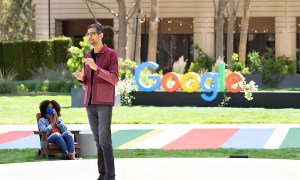

During today’s feature-packed Google I/O conference, Senior VP Vic Gundotra unveiled some of the major enhancements coming to Google+, Google’s social networking platform. Users will see 41 new features across three major areas – Stream, Hangouts, and Photos – with Photos getting some nifty changes.
On the desktop, Google+ is moving from a single stream to a multi-column layout that it introduced in its smart apps, allowing for greater design and depth. With photos and videos, this means they can span multiple columns “so you can get something that’s truly immersive,” Gundotra said. Google automatically analyzes the content, and places appropriate “related hashtags,” automatically ranking it and showing you related items. On stage, Gundotra showed a picture of the Eiffel Tower in Paris. There is no mention of the Eiffel Tower in the comments, but Google can use image analysis to determine that it’s the Eiffel Tower and automatically tag it.
In Hangouts, Gundotra says half of all conversations on Google+ happen in private circles, and Hangouts is about “conversations that last with people you love.” You can turn on history and save the conversations, which includes all photos. And, photos shared in conversations are stored in albums. Gundotra said that “face-to-face-to-face is the best form of conversation,” so Google is making group video a feature at no charge.
In the dedicated Photos area, Google is adding more and enhanced tools to help users create better images.
“Photography can be a rewarding experience. It captures the most important moments of my life,” Gundotra said. “Photography is very labor intensive … time that many of us don’t have. We think we can give you some of your time back.
“Combining your camera and our cloud, we can do some of those labor-intensive tasks for you.”
In terms of photos, the cloud is synonymous with backup, but Google wants to add three new “auto” features to the mix: highlight, enhance, and awesome.
The first change is that cloud storage for photos will remain unlimited at standard size (photos less than 2,048 pixels) but will increase to 15GB for full-size images. “Why does full resolution matter? When you have an important image, you want all the pixels because some memories are not meant to be downsized,” Gundotra said.
The next component, highlight, is designed to help users weed out hundreds of photos, down to the best ones, or the highlights. A feature similar to what Everpix has rolled out, highlight dives even deeper. The reason for this feature is that “it takes time to do all this stuff; Google+ can pick the best pictures for you,” said Gundotra, who used his 600 vacation photos of a trip to New Zealand as an example. Google scanned through those photos, eliminating those that are blurry, duplicates, and poorly exposed. Highlight also recognizes important landmarks and looks for people who are happy or smiling, as well as accounting for aesthetics and affinity – whether the subjects of the photo are in your close Circles.
“We think you’re gonna love it and it’s gonna save you time,” Gundotra said.
Photo-editing tools aren’t new, nor are one-push auto fixes, but Google+ has enhanced this feature set to help users achieve professional-level photos without having to learn how to use intensive software. The auto enhance button is designed to “make your memories look beautiful” by looking at things like tonal distribution, skin softening, noise reduction, structure, white balance, vignette, sharpening, red eye removal, and more.
With tonal distribution, the software will fix under and overexposed images. Beyond standard face recognition, skin softening looks at hairline, teeth, eyes, jewelry, etc., and can separate them out as the software is tweaking the image gently. Noise reduction helps fix images that have a lot of grain and noise due to low light, and structure brings back depth to what is a flat-looking image.
“All you have to do is upload y our images, and we will apply all of this for you on all your photographs, while still giving you control,” Gundotra said. “We think this is amazing and it’s gonna save you lots of time.”
The final new component Gundotra showed off is auto awesome. In his words, “auto awesome creates a new image from one that didn’t exist.” For example, with photos taken in burst mode – a series of similar photos taken in rapid succession – Google+ will automatically create short animated GIFs out of them. (Google has been scanning through users’ photos in the past two weeks and automatically creating these GIFs that will appear when the updated service is turned on). Other effects include high dynamic range, automatic collage creation of multiple portraits of people, auto stitching of images of the same spot to create a panorama photo, and automatic creation of a new photo from multiple similar photos that ensures everybody is smiling in it.
Online photo albums and editing tools aren’t new, but, as Gundotra mentioned, Google wants to go beyond just storage and the tools that are currently available to users. Is it enough to steer people away from other popular photo platforms such as Facebook and Flickr? We will test out the new features once they are available, and let you know.


